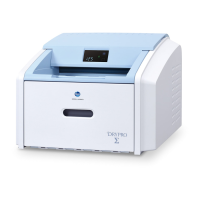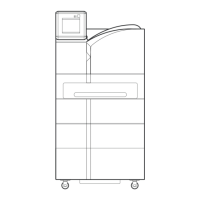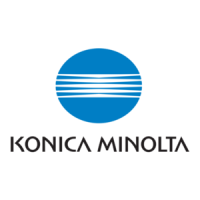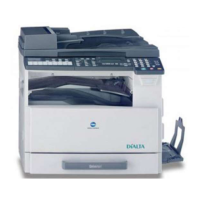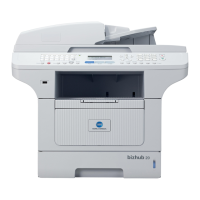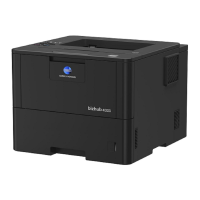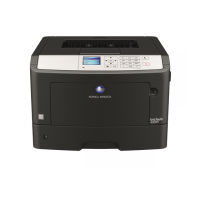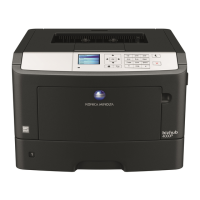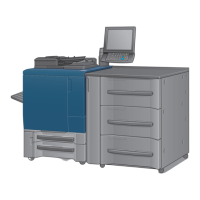Do you have a question about the Konica Minolta DRYPRO SIGMA 2 and is the answer not in the manual?
Details the primary internal components and their functions within the imager.
Explains the operational process of the imager, including image reception and printing.
Illustrates the step-by-step process of printing an image onto film.
Lists the various film dimensions compatible with the imager.
Describes features and support for mammography image printing.
Details the imager's automated system for adjusting image quality.
Guide to configuring and monitoring the imager via its web interface.
Instructions for professional installation, initial setup, and safety precautions.
Explains symbols, notes, cautions, and warnings used in the manual.
Explains the imager's display screen elements and status indicators.
Information on locating and operating the imager's power switch.
Step-by-step guide to powering on and starting the imager.
Procedures for handling power interruptions and emergency shutdowns.
Instructions for restarting the imager to resolve errors.
Details on film counts, size, type, and empty cartridge indicators.
Explains display indications for requested film size or type.
Procedure for removing an empty film cartridge and inserting a new one.
Guide to changing film cartridges to meet specific print job requirements.
How to cancel print jobs that require unsupported media.
Instructions for performing film calibration to ensure optimal image quality.
How to initiate test prints for verifying imager operation.
Information on accessing internal parts by opening or removing covers.
Guide to using the web portal for advanced configuration and monitoring.
Introduction to how the imager reports status and error conditions.
Guidelines and procedures for routine preventive maintenance.
Information regarding the imager's filter, its function, and replacement.
Step-by-step instructions for replacing the imager's filter.
Indicates a required preventive maintenance service call.
Describes how error codes and symbols appear on the display screen.
Troubleshooting steps for calibration failures shown by error codes.
Procedure for restarting the imager when prompted by a restart symbol.
Guidance on identifying, clearing, and resolving film jams.
How to use the web portal for detailed error analysis and status.
Detailed list and interpretation of subsystem error codes and messages.
Status messages related to DICOM communication protocols.
Overview of imager status indications via display and web portal.
Information on status messages related to the film supply.
Status messages related to print job management and queue.
A comprehensive list of condition codes and their resolution actions.
Procedure to clear a film jam in Area 1.
Procedure to clear a film jam in Area 2.
Procedure to clear a film jam in Area 2.
Procedure to clear a film jam in Area 2 or 3.
Procedure to clear a film jam in Area 3.
Troubleshooting steps if the imager's display screen is unresponsive.
Information on what to do when requiring assistance from service personnel.
Details the film's responsiveness to infrared light.
Describes the diagnostic quality and characteristics of the film images.
Discusses the environmental considerations for the laser imaging film.
Guidelines for proper storage and handling of unexposed film.
Recommendations for handling and long-term archiving of processed film.
Information on the film's resistance to humidity and water exposure.
Details on how the imager manages processing odors.
Information on the heat generated by the imager and its impact.
Guidance on the recycling and disposal of used laser imaging film.
Lists the physical dimensions and weight of the imager.
Site requirements for imager placement, including clearance and surface.
Specifies temperature, humidity, altitude, and noise level requirements.
Details network connectivity, protocol, and security considerations.
Details the primary internal components and their functions within the imager.
Explains the operational process of the imager, including image reception and printing.
Illustrates the step-by-step process of printing an image onto film.
Lists the various film dimensions compatible with the imager.
Describes features and support for mammography image printing.
Details the imager's automated system for adjusting image quality.
Guide to configuring and monitoring the imager via its web interface.
Instructions for professional installation, initial setup, and safety precautions.
Explains symbols, notes, cautions, and warnings used in the manual.
Explains the imager's display screen elements and status indicators.
Information on locating and operating the imager's power switch.
Step-by-step guide to powering on and starting the imager.
Procedures for handling power interruptions and emergency shutdowns.
Instructions for restarting the imager to resolve errors.
Details on film counts, size, type, and empty cartridge indicators.
Explains display indications for requested film size or type.
Procedure for removing an empty film cartridge and inserting a new one.
Guide to changing film cartridges to meet specific print job requirements.
How to cancel print jobs that require unsupported media.
Instructions for performing film calibration to ensure optimal image quality.
How to initiate test prints for verifying imager operation.
Information on accessing internal parts by opening or removing covers.
Guide to using the web portal for advanced configuration and monitoring.
Introduction to how the imager reports status and error conditions.
Guidelines and procedures for routine preventive maintenance.
Information regarding the imager's filter, its function, and replacement.
Step-by-step instructions for replacing the imager's filter.
Indicates a required preventive maintenance service call.
Describes how error codes and symbols appear on the display screen.
Troubleshooting steps for calibration failures shown by error codes.
Procedure for restarting the imager when prompted by a restart symbol.
Guidance on identifying, clearing, and resolving film jams.
How to use the web portal for detailed error analysis and status.
Detailed list and interpretation of subsystem error codes and messages.
Status messages related to DICOM communication protocols.
Overview of imager status indications via display and web portal.
Information on status messages related to the film supply.
Status messages related to print job management and queue.
A comprehensive list of condition codes and their resolution actions.
Procedure to clear a film jam in Area 1.
Procedure to clear a film jam in Area 2.
Procedure to clear a film jam in Area 2.
Procedure to clear a film jam in Area 2 or 3.
Procedure to clear a film jam in Area 3.
Troubleshooting steps if the imager's display screen is unresponsive.
Information on what to do when requiring assistance from service personnel.
Details the film's responsiveness to infrared light.
Describes the diagnostic quality and characteristics of the film images.
Discusses the environmental considerations for the laser imaging film.
Guidelines for proper storage and handling of unexposed film.
Recommendations for handling and long-term archiving of processed film.
Information on the film's resistance to humidity and water exposure.
Details on how the imager manages processing odors.
Information on the heat generated by the imager and its impact.
Guidance on the recycling and disposal of used laser imaging film.
Lists the physical dimensions and weight of the imager.
Site requirements for imager placement, including clearance and surface.
Specifies temperature, humidity, altitude, and noise level requirements.
Details network connectivity, protocol, and security considerations.
| Power Requirements | AC 100-240V, 50/60Hz |
|---|---|
| Type | Thermal Laser Printer |
| Film Sizes | 8 x 10 in., 10 x 12 in., 11 x 14 in., 14 x 14 in., 14 x 17 in. |
| Connectivity | Ethernet |
| Power Consumption | Approx. 1.5 kW |
| Throughput | 90 films/hour (14x17 inch) |
